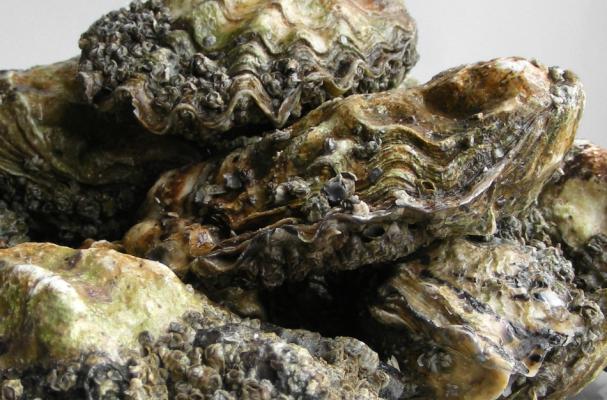
Some people love 'em, some people hate 'em. When I think about them, phrases that you would expect to find in a Dr. Suess book spring into conscientiousness.. "I would eat them with my favorite brew, I would eat them in a simple stew. I would eat them standing on a hill, I would eat them with some dill. I would eat them here. I would eat them there. I would eat them anywhere!"
But by far, there is nothing better than slurping fresh, briny oysters along the waters edge right after harvest; a rare and wonderful part of living on the coast. But beyond being culinary delights, these lovely little bivalve serve an important purpose in our watersheds and are critical to preserving our ecosystems.
Nature has created a perfect little mechanism for cleaning the water and a single oyster can filter 20 - 40 gallons of water per day (Source: Puget Sound Restoration Fund, 2010). This filtration system is so efficient that shellfish farmers looking for the prized Geoduck (pronounced Gooey-Duck), fly over mudflats looking for especially clean areas of water as a way to pinpoint this delicacies location. While the idea of eating something that is filtering our waters may turn people off from eating them, those of us that love oysters have a real incentive to protect their habitat.
So in an effort to protect, preserve and feed our need for these treasures, we became members of the Port Madison Shellfish Farm, a local shellfish CSA (Community Supported Agriculture) on Bainbridge Island. Like most CSAs, you purchase a share and throughout the season, get a bountiful supply of slurping. This CSA also allows you to help with the harvest so after donning our knee high mud boots and gloves, we headed across the Port Madison mud flats to where the shellfish were "planted".

I had assumed that we would be digging through the mud trying to find the oysters, but it ended up being much easier as "planted oysters" are put in mesh bags that are staked to the beach. All you do is cut free the bags and sort through the oysters to find the ones that are mature enough for harvest. Each oyster bag had roughly 12 -15 dozen oysters that 6 months earlier where small little "seed" oysters. Volunteer members open bags and pull out the oysters for sale at farmers markets, local restaurants, grocery stores and, of course, us lucky CSA members. This CSA also sells “starter kits” to shoreline owners so that they can plant and harvest their own oysters.

After the harvest, we all took part in that ancient ritual of shucking, slurping and throwing the spent shells back to the sea. If you enjoy oysters, clams, mussels, scallops or any other bivalves in your local fresh or salt waters, do your part to help preserve and protect their habitat. Some easy efforts to help the oyster is to:
• Don’t use chemical fertilizers in your garden or lawn
• Pick up after your pet
• Dispose of household chemicals and waste responsibly
• Control water run-off by landscaping with permeable materials that allow water to go into the ground (and filter it)
• Join or start a local shellfish farm or purchase local shellfish at your grocery store
Your efforts will be reciprocated through cleaner water and fabulous food.
Grilled Oysters on the Half Shell
- 1 stick of butter
- 3 cloves of garlic, minced
- 1/4 c. assorted fresh herbs (we use Tarragon, Chives, Parsley and Thyme), minced (reserve a fourth of the herbs for later)
- 1/2 c. White Wine
- 1/2 c. Parmesan Cheese, grated
- Salt & Pepper, to taste
- 2 dozen large Oysters
1. Prepare butter sauce – on stove top, melt butter and add garlic. Add 3/4ths of prepared herbs (saving rest for later) and wine; stir to combine. Take butter sauce off heat and add cheese and salt/pepper to taste. Keep warm but off high heat to prevent burning.
2. Prepare oysters - Clean oysters of all dirt and debris using a potato brush. Preheat grill or open flame fire. Place whole oysters on grill grate (you will shuck – or open – later) over direct flame with hinges up. Cook for 3 minutes or until you see liquid starting to escape from the sides.
3. Shuck oysters - Using tongs, remove pre-cooked oysters from grill and carefully shuck using an oyster knife and gloves (CAREFUL: OYSTERS WILL BE HOT). Place knife in hinge and pry top-shell off, being careful not to spill juices. Gently loosen oyster from bottom shell with the knife but let it sit in the bottom shell with the juices as this will be put back on the grill. Complete this for all oysters before returning to the grill. For instructions on how to shuck an oyster, see this great tutorial by Hama Hama Oyster Blog.
4. Finish Oysters - Return Oysters to grill over direct heat/flames. Carefully spoon butter sauce on top of each open oyster. Flames will flare up which is a good thing to get the smoky flavor, but take care to have hands, arms and eyebrows away. Allow oysters to cook for 3 minutes or until golden brown.
5. Serving – Remove oysters from grill and sprinkle with remaining herbs. Serve on half-shell with fresh bread (we like Pane d’ Amore Sourdough). Oysters can be slurped directly out of shell or you can use a small shellfish fork to enjoy.
NOTE: Oyster shells can be cleaned off and then broken/ground up into a fine powder (using a hammer, a burlap bag and safety glasses) and fed to chickens or added to your compost pile.
To learn more about Oysters and the Port Madison Petites that we recommend, please click here!
Image Sources:










